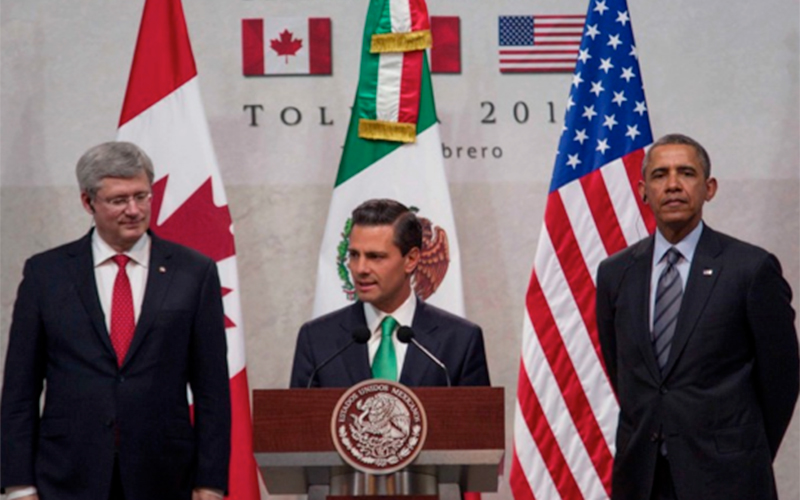Since NAFTA launched on January 1, 1994, trade between the three nations has tripled to top $1.2 trillion per year and investments have quadrupled.

Thanks in large part to the framework established in the 1994 North American Free Trade Agreement (NAFTA), the economies of the U.S., Canada and Mexico have become integrated on an unprecedented level. Since the agreement, trade between the three has more than tripled and now tops $1.2 trillion annually, while investments have quadrupled, laying the groundwork for many companies to operate on a continent-wide basis, tapping into a market that consists of some 450 million people and nearly $20 trillion in total economic activity.
“Before NAFTA and after NAFTA, we have built a relationship between the U.S. and Mexico, between Mexico and the U.S,” President Enrique Peña Nieto says. “We have been able to build an intense relationship with a growing trade growth…We have a trade exchange that ranges around $1 million a minute. And being Mexico, the third top trade partner of the United States, and the second destination of its exports, and being Mexico, a country that buys more from the United States than all of the BRICS countries together – more than Brazil, Russia, India, China, and South Africa, together. That is how important it is for the United States and the same, the U.S. is very important for Mexico, because the U.S. is a top destination of our exports.”
While it has at times been the subject of intense debate, many economists credit NAFTA with helping U.S. manufacturing become more competitive globally, and its effect on trade and investment on both sides of the border has been undeniable. The United States, for example, represents the largest source of foreign direct investment (FDI) in Mexico. Its stock of FDI in Mexico increased from $15.2 billion in 1993 to over $100 billion currently – a nearly 560% expansion. While lesser known, Mexican FDI in the United States has seen an even greater leap, moving from just over $1 billion in 1993 to more than $15 billion today, representing a 1400% increase.
A look at the trade numbers shows a similar story. Between 1993 and 2013, total U.S. trade with Mexico increased by more than 522%, nearly double the rate of non-NAFTA countries. Mexico and Canada now make up the two largest markets for U.S. exports in the world, together accounting for one out of every three dollars the U.S. earns from exports. U.S. exports to Mexico increased rapidly since NAFTA, leaping from $41.6 billion in 1993 to $226.2 billion in 2013, an increase of 444% according to research done by the U.S. Congressional Research Service. U.S. service exports to Mexico have also made impressive gains: U.S. private services exports to Mexico multiplied from $10.4 billion in 1993 to $27.4 billion in 2012.
Pointing to these numbers as evidence, policymakers argue that having an active cross-border marketplace has proved to be an important asset for the United States.
“Mexico is one of the most open economies you can find in the world,” Mr. Peña Nieto emphasizes. “Mexico has decided to be an open economy, and Mexico is considered the fifth most open economy in the G20 countries…I believe that today, the world is defined by what happens in specific regions, and when we talk about North America, we need to link ourselves better so we can create synergy. We need a joint effort to make this region a more competitive one.”
Mexico’s strong record in favor of trade and investment agreements gives credence to these statements. According to figures from the United Nations, Mexico ranks in the top 10 of countries globally in terms of the attractiveness of its investment climate, and has signed more free trade agreements than any other country in the world.
At the time it went into effect, NAFTA represented the most comprehensive and far-reaching free trade agreement in the world and contained several groundbreaking provisions. Since then, economists argue, it has helped North American industries, especially the U.S. auto industry, become more globally competitive through the development of global supply chains. In serving as a foundation and a template for future economic cooperation, its impact continues to be felt strongly today.
By strengthening the framework created two decades ago by NAFTA, argues Mr. Peña Nieto, “We will be able to generate a stronger synergy to carry out joint efforts to make this region a more competitive one.
Development that Mexico will show in its energy sector without a doubt will make it – this region more competitive, and it adds up to what the U.S. has contributed to, specifically in the area of exploiting shale gas, and also to have inputs that are more affordable compared to other places in the world, this is where we should target our efforts. We need to work in the space of mutual respect, but we have to link efforts and create synergies. We want a win-win situation for North America and each one of its components.”
0 COMMENTS